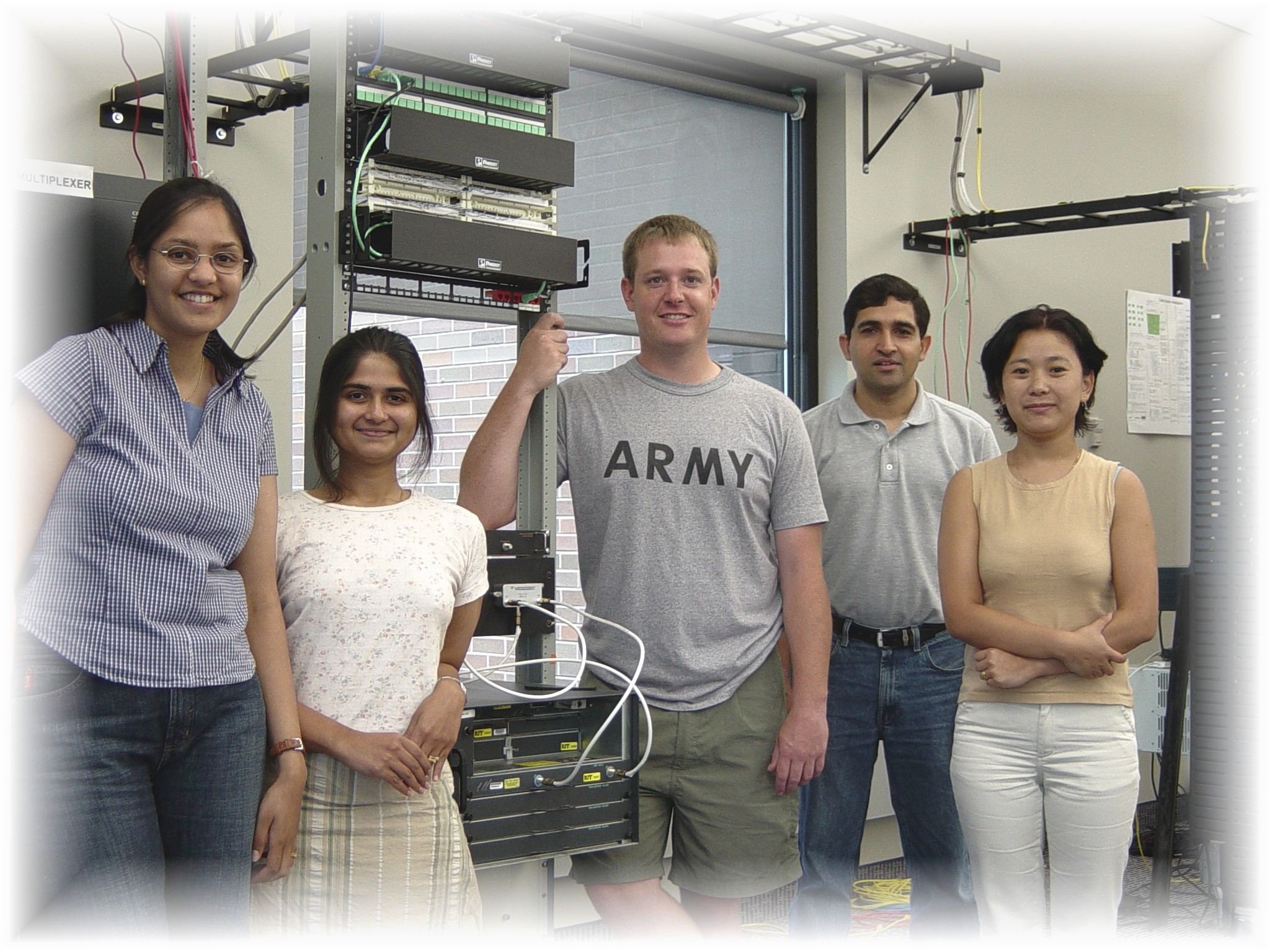
Faculty Members: Dr. Nirmala Shenoy and Prof. Bruce Hartpence
Cisco Champion: Rafael Mantilla, Montalvo Ph. D
ITS Technical Support: Andrew Elble
Period of activity: Fall Quarter 2003

Framework for Seamless Roaming, Handoff and QoS Mapping in Next Generation Wireless Networks
------------------------------------------------------------------------------------------------------------------------

|
Faculty Members: Dr. Nirmala Shenoy and Prof. Bruce Hartpence Cisco Champion: Rafael Mantilla, Montalvo Ph. D ITS Technical Support: Andrew Elble Period of activity: Fall Quarter 2003 |

|
-------------------------------------------------------------------------------------------------------------------------
Project Overview and Goals
Various attempts are in progress to integrate the widely deployed disparate
terrestrial wireless networks in order to provide global roaming and seamless
handoff with continued and acceptable Quality of Service (QoS) guarantees. Though
challenging, our proposed framework targets an easily deployable solution with
minimal changes to existing mobility mechanisms within the wireless networks.
The investigators have proposed an open-ended framework, which will harness
existing mobility mechanisms and protocols in current wireless networks. The
framework can be adapted to new and emerging wireless technologies. IPv6 has
been chosen as the core network technology, though the framework can be overlaid
over other core networks with minimal changes. The mobility features proposed
by MobileIP will be used within the core network. Mechanisms for graceful QoS
transitions while crossing different wireless networks are supported.
The framework, which is distributed and hierarchical, comprises of Interface
Control Nodes (ICNs) distributed across the core and the wireless networks.
The ICN functions can be collocated with some existing control nodes within
the core network and the wireless network to ease deployment. The ICNs will
have the protocols and functions to effect seamless roaming and handoff and
provide Quality of Service (QoS) negotiation and mapping to facilitate a graceful
QoS transitions during inter-network movement. The component protocols residing
at the ICNs in the framework will communicate vertically with each other and
horizontally with the corresponding mobility protocols of the wireless networks
to effect a seamless handoff. The Opnet simulation tool and test-beds will be
used for conducting investigative studies on this framework.
Goals
1. To investigate and analyze a distributed hierarchical framework to provide
seamless roaming, handoff and QoS guarantees (via QoS mapping and negotiations)
as users roam across different wireless networks with initial focus on WLANs
and Cellular Networks.
2. The framework will be open-ended and target a) optimal signaling traffic,
b) minimal delays in executing handoff both at layer 2 and layer 3, c) simplicity
in implementation, d) low implementations costs, e) low processing cost, and
f) acceptable QoS support
3. To involve graduate students in the research activity
4. To attract industry participation and input to achieve a deployable solution
that will be useful for the Telecommunications industry
The Framework
The work is being
carried out partly as a simulation study and partly over a testbed set up at
the Lab for Applied Computing. The simulation studies use the framework shown
above to study the implementation issues and feasibility of the framework while
roaming from cellular to cellular network and also while roaming from cellular
to WLANs. The tool used for simulation studies is Opnet. Two separate studies
are being conducted using the simulation approach. One for roaming across different
types of cellular networks and the other for roaming across cellulr and WLANs.
Qos mapping and management studies is yet to be initiated.
The other part of the work involves study of the framework in a test bed using 3 routers and a laptop, which is the mobile node. The study here, however is limited to roaming and handoff issues in WLAN. Initial activities were focussed on implementing MobileIPv4 and studying the performance as the Mobile node roams across different IP subnets. The study involves handoff performance in terms of delays, processing overheads and data loss during handoff. While this is being carried out, initiative to setup a MobileIPv6 testbed and to investigate the support of "user service profile" at the WLAN via a "Profile Server" collocated with the AAA server will be undertaken.
The work done by these students is given in detail below. Meet the team at LAC!

---------------------------------------------------------------------------------------------------------
|
Cellular to cellular roaming scenario The aim of the project is to provide seamless connectivity to the future mobile user traversing across heterogeneous cellular networks by designing a framework that facilitates a handoff between any two cellular networks. This project involves relieving some challenges that mobile users face when traveling across cellular networks that employ different technologies. One of the main goals of this project was to develop a working base model on which the Global Mobility Management Framework can be implemented and tested. This project focuses on the simulation approach to testing the framework. The work began with a basic GPRS model, as the initial focus is in data connections, obtained from the “contributed models” section of the OPNET web site. This base model was changed considerably to meet the needs of our research on user mobility and mobility management. At this point, the data portion of two 3G cellular networks has been modeled. One of the main goals when traversing between the networks, as a mobile user, is to ensure that loss of data or loss of connectivity does not occur as a result of the handoff. For this reason, along with the handoff mechanism, a data redirection process for the active session has also been modeled. As part of the handoff process, context information of the mobile user is also passed on to the new network. Currently, the model is being enhanced to include delays which will be more representative of a realistic environment. Future work Once the enhancements are complete, we will be experimenting with different handoff mechanisms and data redirection processes. The different mechanisms will be compared and results obtained, for the various types of delays encountered by the mobile user, as a result of the handoff to a new network. The model will then be enhanced for voice support and suitable mechanisms to support a voice call continuity as the mobile node moves from one network to another will be studied. Hierarchy extension of the framework is a topic for future study. |
Nithya Ganesh |
The Opnet model being used for the roaming studies
---------------------------------------------------------------------------------------------------------
Dinika Joshi |
Cellular to WLAN and WLAN to Cellular Roaming The focus of this part of the project was to study seamless mobility
issues and protocols while the mobile node is moving from a cellular network
into a wireless LAN hotspot, from WLAN to WLAN and from WLAN to Cellular
networks Future work EXtend the study to the roaming scenarios mentioned above Extend the study for a voice call support Study handoff and redirection mechanisms for voice and data EXtend the framework hierarchy to support roaming across a number of networks
|
---------------------------------------------------------------------------------------------------------
|
Testbed on MobileIPv4 This portion of the project on Mobility looks at how mobility can be achieved across multiple WLANs in different IP subnets. We first had to steup the tes bed facility at the LAC. The configuration is shown below The mobility support is currently accomplished through the use of IP Mobility Support for IPv4 (RFC 3344). Cisco Systems, Inc. has had Mobile IPv4 as a feature of their IOS (Internetwork Operating System) for some time now. We currently have configured the following network. At this time, we can have a mobile node (laptop) that initially resides on the 192.168.1.0/24 (home) network start an FTP session with a server on the 192.168.2.0/24 network and then roam wireless to the 192.168.3.0/24 (foreign) network without loosing connectivity (session timeout). As our mobile node moves into the realm of the Foreign Agent, it will “hear” advertisements describing that the agent is providing Foreign Agent services. The mobile node will see a Care-Of Address in these advertisements and request the Foreign Agent to register and authenticate for the mobile node back to it’s home network (Home Agent). Once the mobile node is authenticated, the Home Agent will tunnel packets originally destined for the mobile node in the home network to the Foreign Agent’s Care-Of Address. The Foreign Agent will then decapsulate the packets and deliver the inner datagram to the visiting mobile node. Once the mobile node moves back to its home network, it will “hear” advertisements again, although this time the mobile node realizes what network (home) it is by the IP address of the advertisements. The mobile node then resumes normal communications. Future work Various scenarios for study under MobileIPv4 were identified. This was to get a better undertsanding of the mobileIP features before moving over to MobileIPv6. These scenarios include Proxy MobileIP by APs Colocated address at the MobileIP In each scenario, the handoff performance will be studied. These parameters are the actucal handoff delay, the packets lost during to redirection, and reduction in throughput during handoff Mechanisms studied by the simutlaion modelling group for handoff and redirection will be implemented to verify the proposed schemes and study the feasibility and processing requirements in real-life conditions
|
E.J. Danielson
|
 |
---------------------------------------------------------------------------------------------------------
Namgyal Dolker |
Roaming studies within a WLAN The study conducted so far involved roaming characteristics of Mobiel Nodes in WLANs at layer 2. Two Cisco APs were set up at a distance in the Lab separated. The configuration of the AP was changed according to the Matrix that is given below to analyse the performance under each of these cases.
Cisco 350 series Aironet Access Points and Cisco 350 series WLAN cards were used for this study. It was seen that with same SSIDs, roaming was possible with no packet loss in any application. Where as with different SSIDs, FTP downloads survived but when pinging, packets are lost. Different combination of FTP servers and clients were used with different SSID with same WEP key and different WEP key and the result is as following. FTP Servers and Clients
Clients were all run on WinXp on the labtops. Only one FTP server was tested on linux. The time-out delays were the default time-out delays. WEP key: “shared” authentication was configured on the APs with full data Encryption. Only one WEP key was used even when there is a provision to allow us to set upto four WEP keys in each AP. Same SSID with different WEP key: There is no roaming possible with this configuration.
With different SSIDs,there was packet loss but no disconnection in TCP
applications. Packet captures were studied and observations were made. Different IP domain: At this point, we have installed the mobile IP client (dynamics) on the mobile node and have tested that the node moves back and forth from the home and the foreign network. In each case the handoff performance parameters namely, the actual time taken for handoff, the packets lost while changing routes, and reduced throughput during handoff will be studied. Future Work The study will be continued on MoibleIPv6. The MobileIP client will be modified to fit in with the specfication defined by us to accommodate the framework The MobileIP client will be interfaced with the proposed "profile server".
|